Episode
1
Losing
the Land
Written &
directed by
ADRIAN REDMOND
Production number 601-101A
Filmed in Alaska 1998-2000
Post production in Denmark 2001
Duration 46 minutes (English version)
Stereo PAL and NTSC
Non-broadcast release on VHS and DVD
Also available in Danish and Greenlandic |
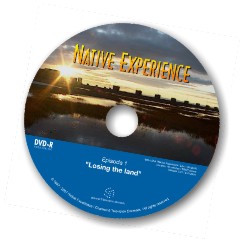 |
|
| |
| The
fight for the land |
| |
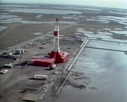 |
The
discovery in 1967 of oil on Alaska's North Slope
unleashed a conflict between the American settlers
and the Eskimo, Indian and Aleut Natives of Alaska -
a conflict which had been building up for many
years.
The United States had bought Alaska from Russia in
1867, and accepted a responsibility of trust - to
protect the land and interests of Alaska's
Natives. |
|
| |
| As
the 20th century unfolded, American settlement of Alaska,
and later Alaska's strategic importance during the Second
World War and the Cold War, would lead to a colonisation
of Alaska, under which the Natives would become a minority
in their own homeland. |
|
The
discovery of oil at Prudhoe Bay resulted in the
need to build the Trans Alaska pipeline, which
would have to cross the Native land.
Alaska's Natives united in their opposition to the
development of the oil fields and the construction
of the pipeline, filing several claims in the US
courts against the state and federal
governments. |
 |
|
| |
| America
needed the oil - but without a solution to the Native
lands claims - the oil industry and the government could
look forward to years of prolonged litigation. Congress
understood the need for a politically acceptable solution
- a settlement with Alaska's Natives. |
| |
 |
It
fell to the younger generation of Natives to lead
the fight for the land, a fight which ultimately
resulted in the passing of the Alaska Native
Claims Settlement Act (ANCSA) in December 1971,
which gave the Natives title to some of their
ancestral lands, together with financial
compensation for lands lost. ANCSA led to the
creation of 12 native-owned regional corporations
and over 200 village corporations which would
manage the lands and capital on behalf of the
Native population. |
|
| |
Alaska's
Natives secured title to over 44 million acres of
land, but ANCSA was not an unequivocal
success.
The Natives lost more land than they won, ANCSA
extinguished all possible Native lands claims in
Alaska, at the same time as it forced the Natives
to adopt a corporate model for the stewardship of
their lands and capital. |
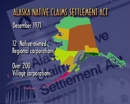 |
|
| |
| "Losing
the land" - the first episode in the "Native
Experience" series, examines the history of Alaska
which led up to the fight for the land in the 1960's. |
| |
|

|
| |
| "Losing
the Land" was filmed primarily on the North Slope and
in Fairbanks, though our original footage is supplemented
by a wealth of historical archive film from the early days
of the oil fields and the construction of the Trans Alaska
Pipeline. |
| |
| As
is the other films in this series, our story is centered
on Native subsistence activities which underline
the relationship between the Native population and
their land and natural environment. In this
episode subsistence life is depicted with
extensive footage of the Inupiat Eskimos
subsistence whaling, filmed over a six week period
on the sea ice off Barrow in the spring of 1999. |
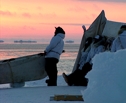 |
|
| |
 |
The
co-operation of both the Alaska Eskimo Whaling
Commission and the Barrow Whaling Captains'
Association gave the "Native Experience"
production team the opportunity to shoot unique
film footage of the Inupiat subsistence whaling
hunt in the spring of 1999. |
|
| |
| Aboriginal
subsistence whaling, as practiced by the Inupiat,
is more than the pursuit of nutrition - it is the
ultimate manifestation of the Inupiat culture - a
tradition which binds entire communities together
and which underlines - perhaps more than any other
aspect of the Inupiat way of life - the necessity
of a community working together and sharing their
subsistence harvest. No man can hunt, butcher and
consume a bowhead whale alone. |
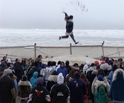 |
|
| |
 |
It
is in the conflict between these traditional
values of Native peoples - symbolised by the
Inupiat and their whaling and the values of the
outsiders - the forces of government, big oil, and
western concepts of land ownership - that the
story of Native Alaska's fight for the land was
born. |
|
| |
| The
following contributed to this film with their interviews - |
| |
Willie
Hensley
George
Ahmaogak Sr.
Morris
Thompson
Richard Frank
Dennis
Tiepelman
Joe Upicksoun
Gary Harrison
Ronald Brower
Eugene Brower
David S. Case
Charles Etok
Edwardsen
Jimmy Stotts
|
| |
| This
episode - "Losing the Land" - tells the
story of the colonization of Alaska - from the
Treaty of Purchase in 1867, through to Statehood
in 1959, the discovery of oil at Prudhoe Bay in
1967 and the growth of the Native lands claims
movement which led up to the Alaska Native Lands
Claims Settlement in 1971. |
 |
|
| |
| This
episode is followed by two "case studies"
(Episodes 2 and 3); which examine the impact of ANCSA on
two different regions of Alaska and by Episode 4; which
examines the overall aftermath of ANCSA in relation to
selected themes that are relevant in Native Alaska today. |
| |
| This
series makes a valuable contribution towards documenting
the history of the Alaska Native Claims Settlement Act and
is recommended viewing for Native and non-native audiences
alike. |
| |
|
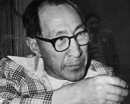
|
| |
|
This
film is dedicated to the memory
of the
Inupiat leader, Eben Hopson Sr.
|
|
|